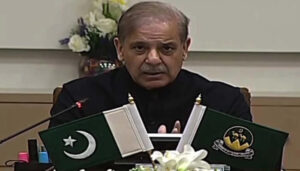• Pakistan, lender reach staff-level agreement on Extended Fund Facility review, another $1.3bn secured for climate resilience
• About Rs7 cut in electricity tariff likely; water pricing to be introduced; gradual end to automobile protectionism on the cards
• IMF appreciates Pakistan’s economic strategy; PM says deal secured without imposing more taxes
ISLAMABAD: Pakistan and the International Monetary Fund (IMF) have agreed to introduce a new carbon levy, reduce electricity tariffs, increase water pricing, and open up the automobile sector to global trade under the Staff-Level Agreement (SLA), announced on Wednesday.
“The IMF team has reached a SLA with the Pakistani authorities on the first review of the 37-month Extended Arrangement under the Extended Fund Facility (EFF), and on a new 28-month arrangement under the IMF’s Resilience and Sustainability Facility (RSF) with total access over the 28 months of around $1.3 billion,” the Fund said in a statement.
This takes the combined volume of IMF support for Pakistan to about $8.3bn.
The agreement is subject to the approval of the IMF’s Executive Board. Upon approval, Pakistan will have access to about $1bn under the EFF, bringing total disbursements under the programme to about $2bn.
Senior officials privy to the SLA entailing the Memorandum of Economic & Financial Policies (MEFP) said that about Rs7 per unit reduction in average electricity rates would be announced by the prime minister in a few days, but with effect from April 1, 2025.
Other major steps — carbon levy, water pricing and automobile protectionism — would be gradual, with implementation starting from July 1, 2025. The overall fiscal consolidation will continue in the upcoming budget through a reduction in energy subsidies and tight development spending.
Officials said the government had requested a reduction in the GST rate on electricity to bring down costs. The IMF did not allow any more distortions in the GST system, but allowed the use of a higher petroleum levy to compensate for power tariffs.
A Rs10 per litre increase in the petroleum levy was estimated to provide a roughly Rs1.80 per unit cushion. The combined impact of savings from all power purchase agreements and pending quarterly tariff adjustments would mean about Rs7 per unit reduction in the overall rate, to be announced by the prime minister on a date of his choice.
Officials said the government has committed to introducing a carbon levy on all hydrocarbons, including petroleum products and coal, starting with Rs3-5 per litre or equivalent. This will gradually increase. The revenue will be spent on specific climate-related expenses.
Average trade tariffs (such as custom duties) for the automobile sector would also be reduced from about 10.5pc to 6pc from now on to FY2030. Both the IMF and the authorities agreed that the auto sector had enjoyed too much protection for far too long, and this should end.
The cabinet approvals for these two measures would be shared with the IMF and then introduced through the finance bill 2025-26 for implementation with effect from July 1, 2025. Water pricing would also be approved in consultations with the provinces and be dealt with separately, sources said.
Macroeconomic stability
The IMF appreciated the significant progress made by Pakistan over the past 18 months in restoring macroeconomic stability and rebuilding confidence despite a challenging global environment.
While economic growth remains moderate, inflation has declined to its lowest level since 2015, financial conditions have improved, sovereign spreads have narrowed significantly, and external balances are stronger.
The Fund also highlighted elevated downside risks and warned against potential macroeconomic policy slippages driven by pressures to ease policies along with geopolitical shocks to commodity prices, tightening global financial conditions, or rising protectionism, which could undermine the hard-won macroeconomic stability.
Additionally, climate-related risks continue to pose a significant challenge for Pakistan, creating a need to build resilience, including through adaptation measures.
“In this regard, it is critical to stay the course and entrench the progress achieved over the past one and a half years, building resilience by further strengthening public finances, ensuring price stability, rebuilding external buffers and eliminating distortions in support of stronger, inclusive and sustained private sector-led growth,” it said.
The authorities are on track to achieve an FY25 underlying primary surplus of at least 1pc of GDP and committed to sustaining consolidation in the FY26 budget. While refraining from increasing current spending beyond that budgeted, the government would further reduce energy subsidies and prioritise development spending.
The government would continue to enhance revenue mobilisation, spending efficiency and transparency, and broaden the tax base. Agriculture Income Tax (AIT) regimes in the provinces for implementation with effect from July 1, 2025 and greater fiscal devolution in FY26 would be ensured.
Pakistan also committed to maintaining an appropriate tight monetary policy based on data to ensure inflation remained anchored within the State Bank of Pakistan’s (SBP) medium-term target range of 5–7pc and also to preserve “a fully functioning foreign exchange market to support exchange rate flexibility while rebuilding FX reserve buffers”.
The fundamental cost-reducing reforms in the energy sector will continue to enhance viability and lower tariffs. Tariff adjustments would remain a priority to reduce the stock and flow of the sector’s circular debt. The government would accelerate cost-side reforms, including improving distribution efficiencies, integrating captive power into the electricity grid, enhancing the transmission system, privatising inefficient generation companies, and expanding renewable energy adoption.
The government will advance its efforts to fully implement the SOE governance framework across all SOEs, while adopting appropriate governance mechanisms and safeguards for the Pakistan Sovereign Wealth Fund (PSWF).
Under the RSF, the government will strengthen public investment processes across all levels of government to prioritise projects that enhance disaster resilience; improve the efficiency of scarce water resource usage; enhance intergovernmental coordination on disaster financing; improve information architecture and disclosure of financial and corporate climate-related risks; and promote green mobility to mitigate significant pollution and adverse health impacts.
APP adds: Speaking during the federal cabinet meeting on Wednesday, Prime Minister Shehbaz Sharif hailed the staff-level agreement with the IMF, saying that the agreement was achieved without the need for additional taxation measures, proving the government’s resolve and planning.
He acknowledged the hardships faced by common people, who had borne the burden of a price hike during the process of achieving economic stability. He also paid tribute to salaried persons who contributed a major portion in tax collection.
The government will receive $1.3 billion from the IMF, which will bolster Pakistan’s foreign reserves to $8.3 billion, the prime minister said. He also highlighted the contributions of all the provincial governments in supporting the federal government in securing the IMF agreement.
Published in Dawn, March 27th, 2025









